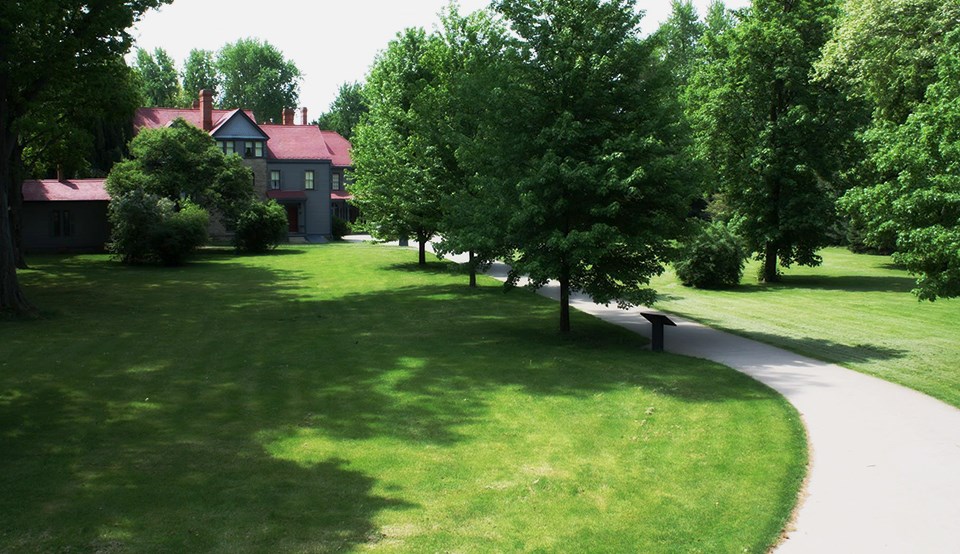Last updated: November 6, 2024
Article
James A. Garfield National Historic Site Cultural Landscape

NPS
Introduction
In 1880, thousands of visitors and reporters traveled to Congressman and presidential candidate James A. Garfield’s Mentor, Ohio farm to hear him deliver campaign speeches from his porch. They trampled grass, camped on the grounds, and even helped themselves to farm crops. His campaign methods proved effective, and the Republican Garfield defeated Democratic candidate General Winfield Scott Hancock for election as the twentieth President of United States. The farm supported Garfield’s identity as a “gentleman farmer” and his opposition to big city political corruption.
Library of Congress
The Garfield farm, nicknamed “Lawnfield,” remains significant for its association with President Garfield and its distinctive design. It is historically significant from 1886 to 1899, during the “period of transition,” in which major changes occurred at the property. After President Garfield’s assassination in 1881, his widow, Lucretia Rudolph Garfield, made many improvements to the buildings and landscape. James A. Garfield National Historic Site was authorized on December 28, 1980. The NPS worked with the Western Reserve Historical Society of Cleveland, Ohio to continue preservation and interpretation efforts until 2008.
Landscape Description
The James A. Garfield National Historic Site's cultural landscape occupies 7.8 acres in Mentor, Ohio. The cultural landscape contains eight extant buildings from the period of significance, including the main home, tenant house, carriage barn, and windmill. The building arrangement mirrors the narrow north/south orientation of the property. The main residence and stylistic elements sit to the south separate from the northern agrarian structures. The main home exemplifies several different architectural styles including Victorian Gothic, Queen Anne, and Federal Revival.
The original 160 acre property contained crop fields, pastures, and an orchard. Trees that relate to the period of significance included sugar maples, Cornelian cherry, black locust, white birch, mulberry, and dogwood, among others. Several large historic trees are clustered around the home and throughout the property. An orchard that is representative of the historic type is planted in the northwest corner of the property. Small scale features include a watering trough, hitching post, and carriage mounting step.

NPS / Harpers Ferry Center Art Collection
Historic Use
The Garfield family purchased the farm in 1876. By then, James Garfield had been in Congress for thirteen years. Before politics, Garfield had been a teacher, state senator, and Union army general. He believed a farm would contribute to his children’s upbringing, as it had his own. Farming could also provide additional income and the Garfields made many improvements to support productivity. In the 1870s, they grew wheat, oat, barley, buckwheat, corn, rye, and hay grasses. Livestock included swine, horses, cows, and poultry.
When not working as the representative of Ohio's nineteenth congressional district, Garfield attended to the farm. He experimented with soil amendments and hydrological innovations. James Garfield was interested in ram technology to deliver water for the household and to irrigate fields. A bog existed onsite and was separated from the rest of the site by an “ancient shoreline” or slight rise in the topography.

Historic American Buildings Survey, Library of Congress

NPS
Mrs. Garfield added a memorial library to the home in 1885-86. Today, that library is recognized as the birthplace of the presidential library idea. The Romanesque-style windmill, built in the early 1890s, served as both an aesthetic and functional feature. It provided water to the house and farm. The family also commissioned J. Wilkinson Elliot, a landscape architect out of Pittsburgh, to create a unified landscape design.
Portions of the property passed from Mrs. Garfield to her children and developers. The Western Reserve Historical Society commenced acquisition, preservation, and interpretation efforts in the late 1930s. On December 28, 1980 Congress authorized the establishment of James A. Garfield National Historic Site.
Today, visitors can experience the James A. Garfield National Historic Site to better understand the life of the president and his interest in agrarian pursuits. The landscape also remains significant for its association with nineteenth century agriculture and deliberate landscape design.
Quick Facts
- Landscape Type: Historic Site
- National Register Significance Level: National
- National Register Significance Criteria: B, C
- Period of Significance: 1886-1899
- National Historic Landmark
Landscape Links
- Lawnfield Cultural Landscape Report, James A. Garfield National Historic Site (1994)
- Lawnfield Historic Structure Report, James A. Garfield National Historic Site (1991)
- National Register of Historic Places: "Lawnfield," James A. Garfield Estate
- Library of Congress: HABS/HAER/HALS Documentation
- James A. Garfield Papers, Library of Congress
- More about NPS Cultural Landscapes

